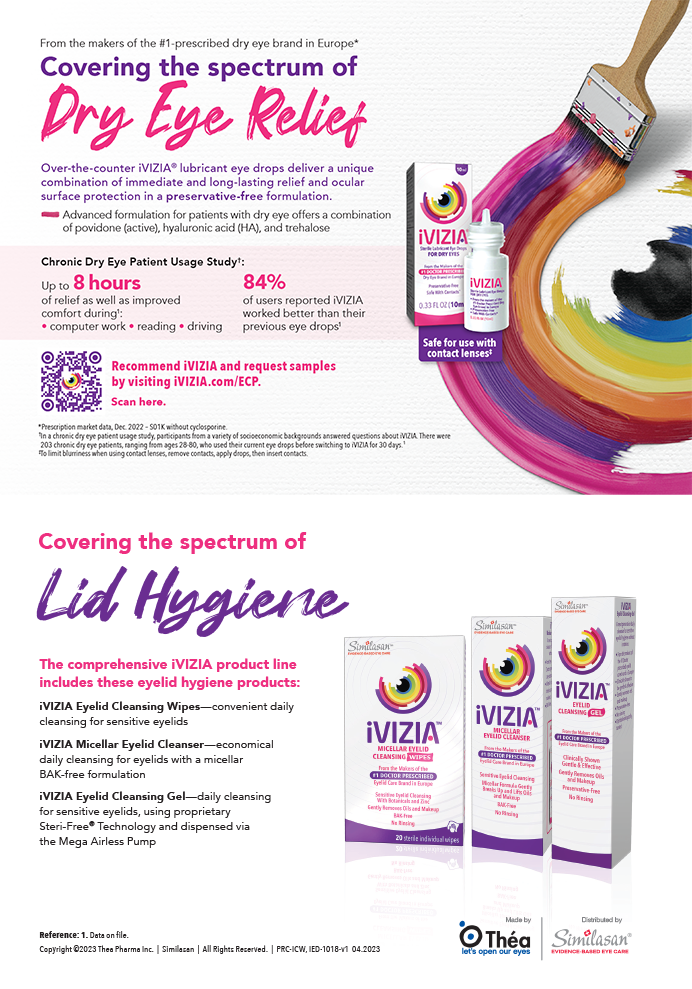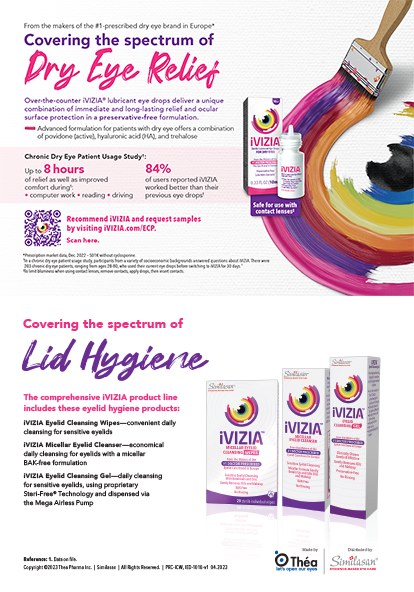Without a doubt, the technology surrounding cataract surgery is amazing. Femtosecond lasers can drastically reduce the use of ultrasound energy within the eye, premiums IOLs improve vision at all distances, and precise technology can even eliminate astigmatism. Patients achieve excellent vision within 24 hours of surgery, and the cataract procedure is one of the safest in all of medicine. Then, you have the drops.
Endophthalmitis is the primary fear after cataract surgery, and the way to mitigate it is pharmacological prevention. A close second to that fear is acute and chronic inflammation, which not only decreases patients’ satisfaction but can also lead to permanent vision loss. Because the peak incidence of cystoid macular edema is 4 to 6 weeks after surgery,1 therapy generally lasts that long. Although the intentions are good, patients’ compliance with topical therapy after cataract surgery is miserable. One study found that 50% of patients took less than half of the prescribed medication and that 20% took less than a quarter.2
THOSE DREADED DROPS
If you speak to any cataract surgeon’s staff, you will quickly discover that drops are the bane of their existence. Doctors often mistrust the preservatives used in generic drops, but the copayments on branded medications can be inaccessible for patients. Patients head to the pharmacy on Saturday and spend $200 on a noncovered drop, because they are worried about their Monday morning surgery. They are then irate to have paid that much. Even when cost is not a factor, understanding and compliance are poor.
Sydney Tyson, MD, MPH, a cataract and refractive surgeon relates, “Despite our best efforts, patients have no idea how to administer their drops correctly. We print instruction sheets with pictures and create tables with checkboxes for each time a patient needs to take a drop. Regardless, if it is unilateral or bilateral, patients are completely confused. I would say that 70% of all calls we receive from postoperative patients are related to their drops.”
Certainly, the downside of drops is enough to start people thinking outside the box. Kevin Scripture, MD, a fellow cataract and refractive surgeon recalls, “I first heard James Gills, MD, speak about dropless cataract surgery at the American Society of Cataract and Refractive Surgery meeting in 2005, and it was enough to entice me to perform a trial in my practice. My first cohort included 10 patients that were given intravitreal transzonular triamcinolone and gatifloxacin. Following the success of the initial 10 patients, I expanded the trial to 100 patients. In May 2005, I started performing dropless surgery on all of my cataract patients, save those who are allergic to quinolones or have severe glaucoma. I have now performed more than 20,000 dropless procedures.”
THE POSSIBILITIES OF INTRACAMERAL ANTIBIOTICS
Steve A. Arshinoff, MD, is a pioneer in using moxifloxacin (Vigamox; Alcon) right out of the bottle.3 European studies of intracameral antibiotics showed efficacy, but often included compounding formulas that were cumbersome to achieve.4-6 Dr. Gills’ research showed the possibility of intracameral injections of Kenalog (triamcinolone; Apothecon), inspiring further movement in the field. Dr. Tyson had been following these thought leaders in their move to dropless cataract surgery for some time when he was inspired by Dr. Arshinoff’s concept of taking the antibiotic out of the bottle, diluting it, and injecting it.
“I found that injecting the antibiotic intracamerally was a potentially very effective way to control intraocular pathogens, and I stopped prescribing antibiotics postoperatively,” he says. “That led to my desire to find a way to eliminate postoperative steroid drops as well. I perform small-incision cataract surgery, which does not induce a lot of inflammation, so I felt comfortable with that concept. Thus, I had cut my patients down to just one drop of Prolensa [bromfenac 0.07%; Bausch + Lomb] per day postoperatively, and that worked well. But, it was still difficult for some. Prolensa is not covered for all patients, so pharmacists try to substitute the generic formulation that requires more frequent dosing and is potentially more corneotoxic. In addition, if patients do not get the one drop per day correctly in their eye, that eliminates all antiinflammatory coverage.”
A BREAKTHROUGH
Dr. Gills also began injecting Kenalog into the sub- Tenon space. Following blood-free cataract surgery by making a cut into the sub-Tenon space and performing a blind injection, however, are a bit extreme for some surgeons. A breakthrough in injectable drugs for cataract surgery arose from the collaboration of an inventor surgeon, Jeffrey Liegner, MD, and a state-of-the art compounding pharmacy. In 2013, Imprimis Pharmaceuticals acquired the intellectual property related to these ophthalmic formulations. The proprietary, patent-pending technologies allow drugs such as triamcinolone and moxifloxacin (with or without vancomycin), which do not typically distribute evenly in a suspension, to be combined in a single medication. The formulations, TriMoxi and TriMoxiVanc, can be injected intothe vitreous at the time of cataract surgery (Figure).
Dr. Tyson states, “When I found out there was a compounded formula of antibiotics and steroid provided by a [Pharmacy Compounding Accreditation Board ]-accredited pharmacy, that could be injected transzonularly into the vitreous, that brought the concept from idea to reality for me. Since November 2013, I have performed more than 1,000 dropless surgeries. Now, all of my cataract surgeries, except in glaucoma patients, are dropless., and the results have been excellent. When analyzing all patients that have undergone the injection, including the initial patients with whom I was still figuring out the nuances of the injection, only 10% end up needing a rescue medication, because the compounded formula wasn’t as efficacious for them. There were no cases of steroid-responsive IOP spikes.”
With more surgeries under his belt, Dr. Scripture reports his rescue rate to be about 5%.
CONCLUSION
Just as glaucoma management is being revolutionized by microinvasive surgeries that can eliminate or reduce the burden of pharmacologic therapy, dropless cataract surgery is the next frontier. “I believe that using intraocular medications in lieu of postoperative drops is a big advantage to patients and doctors,” says Dr. Scripture. “When other physicians discover this is a legitimate alternative to drops, everyone involved will benefit.”
Kevin T. Scripture, MD, is a cataract and refractive surgeon at Whitewater Eye Centers, Connorsville, Indiana. He acknowledged no financial interest in the products or companies mentioned herein. Dr. Scripture may be reached at kscripture@wweyecenters.com.
Sydney L. Tyson, MD, MPH, is an attending surgeon at Wills Eye Hospital, Philadelphia, and the cofounder of Eye Associates as well as the founder and president of SurgiCenter of Vineland, New Jersey. He acknowledged no financial interest in the products or companies mentioned herein. Dr. Tyson may be reached at sydtyson@comcast.net.
- Asano S, Miyake K, Ota I, et al. Reducing angiographic cystoid macular edema and blood-aqueous barrier disruption after small-incision phacoemulsification and foldable intraocular lens implantation: Multicenter prospective randomized comparison of topical diclofenac 0.1% and betamethasone 0.1%. J Cataract Refract Surg. 2008;34(1):57-63.
- Hermann MM, Ustundag C, Diestelhorst M. Compliance with topical therapy after cataract surgery using a new microprocessor-controlled eye drop monitor. Invest Ophthalmol Vis Sci. 2005;46. E-abstract 3832.
- Arshinoff SA, Bastianelli PA. Incidence of postoperative endophthalmitis after immediate sequential bilateral cataract surgery. J Cataract Refract Surg. 2011;37(12):2105-2114.
- Barreau G, Mounier M, Marin B, Adenis JP, Robert P. Intracameral cefuroxime injection at the end of cataract surgery to reduce the incidence of endophthalmitis: French study. J Cataract Refract Surg. 2012; 38:1370-1375.
- Yu-Wai-Man P, Morgan SJ, Hildreth AJ, Steel DH, Allen D. Efficacy of intracameral and subconjunctival cefuroxime in preventing endophthalmitis after cataract surgery. J Cataract Refract Surg. 2008; 34:447-451.
- García-Sáenz MC, Arias-Puente A, Rodriguez-Caravaca G, Banuelos JB. Effectiveness of intracameral cefuroxime in preventing endophthalmitis after cataract surgery: ten-year comparative study. J Cataract Refract Surg. 2010; 36:203-207.


